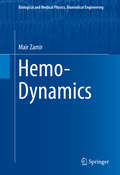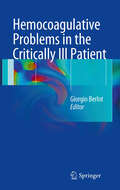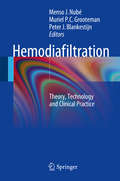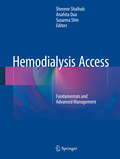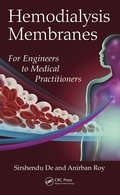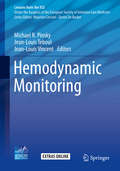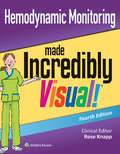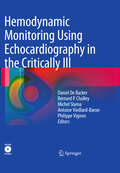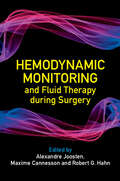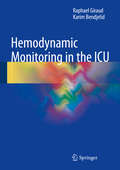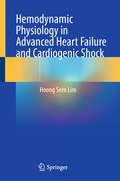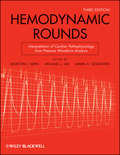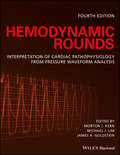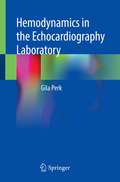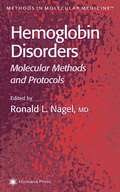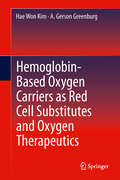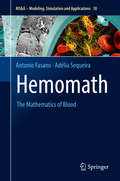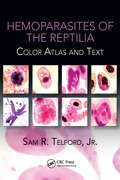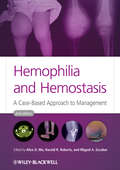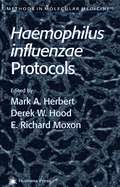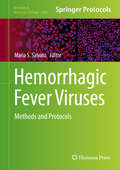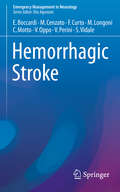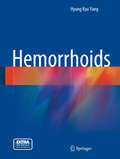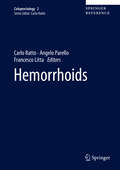- Table View
- List View
Hemiplegie, deel 2 de romp centraal: de romp centraal
by H.P. Raadsen E. van DoornDit boek is het resultaat van meer dan vijf jaar ervaring met patiënten die het ongeluk hadden een hemiplegie te krijgen. Het bevat recente waarnemingen, nieuwe opvattingen over ontwikkelingen van behandelingstechnieken die kunnen leiden tot een beter inzicht in de problemen en een meer succesvolle revalidatie. De heldere foto's illustreren op instructieve wijze de behandelwijze van Pat Davies. Het boek is bestemd voor een ieder die betrokken is bij de revalidatie van hemiplegiepatiënten.
Hemo-Dynamics
by Mair ZamirPraise for Hemo-Dynamics: "This book provides an elegant and intuitive derivation of the fundamental mathematics underlying fluid flow, and then applies these in a straightforward way to pulsatile blood flow in all its complexity. One of the triumphs of the book is that Zamir succeeds in making essential concepts such as the Navier-Stokes equations completely accessible to any reader with a knowledge of basic calculus. The author succeeds in conveying both the beauty of his subject matter, and his passion for the elegance and intricacies of fluid flow more generally. " Lindi Wahl, PhD, Professor of Applied Mathematics, The University of Western Ontario "Incredible, the figures alone are to die for. . . At first glance "Hemo-Dynamics" seems like a deep engineering and modeling dive into the mechanical properties of the cardiovascular system, blood, and how they interact to generate flow and pressure. However, the text is laid out in a stepwise manner and I was especially impressed in the way that the key conceptual figures illustrate the essential concepts. In keeping with the philosophical underpinnings of engineering, Professor Zamir has also constructed his book so that the format, text, equations and the figures are self-reinforcing. This isa book that will be of great use to those who seek to understand the cardiovascular system from a mechanical and m odeling perspective. " Michael J. Joyner, MD, Professor of Anesthesiology, Mayo Clinic, Rochester, MN
Hemocoagulative Problems in the Critically Ill Patient
by Giorgio BerlotSince the very beginning of critical care medicine, much attention has been paid to the risk of bleeding, but only recently the risk of thrombosis has been recognized in critical patients; in fact, current laboratory investigations aimed to monitor blood coagulation are more focused on the assessment of the hemorrhagic than of the thrombotic risk. Since mid-90s, many studies have detected powerful pro-thrombotic actions of endogenous mediators in sepsis and other inflammatory conditions, including trauma and postoperative status. Unfortunately, the related complication are both hard to detect and extremely harmful. The volume provides a full coverage of the hemocoagulative problems in anesthesia and intensive care, taking into consideration the physiology and monitoring of hemostasis, its relation with sepsis, and the specific aspects of the various critical conditions - from trauma to burns, to heart and transplant surgery or acute renal failure.
Hemodiafiltration
by Menso J. Nubé Muriel P.C. Grooteman Peter BlankestijnThis book gives a complete description of online hemodiafiltration, in five sections. It is unique in the systematic and complete way in which hemodiafiltration is described. Each chapter is completed by a point-to-point summary of essential information, in a separate text box. Part of the book is dedicated to the theoretical background of convective clearance. In this part, safety issues and quality control is reviewed (especially on the quality of water for dialysis and substitution fluid), as well as equipment (both dialyzers and machines) with which this treatment can be performed. As recently the results of several randomized controlled trials were available, the effect of hemodiafiltration on hard clinical end points (mortality and morbidity) is discussed in detail. This has not been done before, as the most recent book/journal on hemodiafiltration was published in 2011, before the results of the 3 randomized controlled trials were published. Furthermore, the methodological quality of the trials is discussed by an expert, in order to help the readers in their judgment of the trials Part of the book concentrates on the effect of the treatment on several biomarkers and uremic toxins. Several clinically relevant issues is discussed separately, such as the prescription of anticoagulation during the treatment, drug prescription and clearance for patients treated with hemodiafiltration, and hemodynamic stability. Finally, a practical guide on how to perform the treatment is provided. In this unique section, seemingly simple but important details of hemodiafiltration-treatment is discussed, such as the importance of needle size for blood flow rates, the difference between filtration fraction and substitution ratio, the different targets that can be set and how to reach them. As most literature is mainly focused on theoretical issues, this unique feature really will help the field to perform hemodiafiltration, and answer practical questions.
Hemodialysis Access
by Anahita Dua Sherene Shalhub Susanna ShinThis comprehensive reference on the fundamentals of hemodialysis access creation and advanced management for maintenance is designed to meet the needs of all surgeons and physicians responsible for the treatment and care of patients undergoing dialysis. The book opens by discussing every aspect of dialysis access planning, including selection of the right access for the individual patient and access strategies. Hemodialysis access techniques, from the most basic to the most complex and unconventional, are then described step by step, and guidance is provided on follow-up. Detailed attention is also devoted to the challenging management of specific complications of dialysis access surgery, including failing hemodialysis access. The book includes a wealth of informative, high-quality images and illustrations, and the authors are prominent vascular surgeons, transplant surgeons, general surgeons, nephrologists, and interventional radiologists from across the United States.
Hemodialysis Membranes: For Engineers to Medical Practitioners
by Sirshendu De Anirban RoyBook initiates with introductory material to hemodialysis technology and its historical evolution and later on divulging into the field of biomaterials. With this background, the book discusses selection criteria of a suitable biomaterial for synthesis of haemodialysis membranes along with illustration of a complete indigenous, low cost technology for spinning of haemodialysis fibres. <P><P>Well illustrated description of instruments used for membrane characterization and biomedical engineering is also provided at suitable junctures to effectively present the concept including worked out examples. Present title can be a good textbook as well as a research material for membrane as well as biomedical engineering curricula and provides coverage for appropriate undergraduate and graduate students interested in hemodialysis membranes.
Hemodynamic Monitoring (Lessons from the ICU #42)
by Jean-Louis Vincent Michael R. Pinsky Jean-Louis TeboulThis book, part of the European Society of Intensive Care Medicine textbook series, teaches readers how to use hemodynamic monitoring, an essential skill for today’s intensivists. It offers a valuable guide for beginners, as well as for experienced intensivists who want to hone their skills, helping both groups detect an inadequacy of perfusion and make the right choices to achieve the main goal of hemodynamic monitoring in the critically ill, i.e., to correctly assess the cardiovascular system and its response to tissue oxygen demands. <P><P> The book is divided into distinguished sections: from physiology to pathophysiology; clinical assessment and measurements; and clinical practice achievements including techniques, the basic goals in clinical practice as well as the more appropriate hemodynamic therapy to be applied in different conditions. All chapters use a learning-oriented style, with practical examples, key points and take home messages, helping readers quickly absorb the content and, at the same time, apply what they have learned in the clinical setting. <P><P> The European Society of Intensive Care Medicine has developed the Lessons from the ICU series with the vision of providing focused and state-of-the-art overviews of central topics in Intensive Care and optimal resources for clinicians working in Intensive Care.
Hemodynamic Monitoring Made Incredibly Visual! (Incredibly Easy! Series®)
by Rose KnappBuild a solid knowledge base in hemodynamic nursing skills, with the newly updated Hemodynamic Monitoring Made Incredibly Visual!®, 4th Edition. Full of colorful images that illustrate monitoring concepts and processes, this concise, enjoyable guide sorts through the complexities of hemodynamics and clarifies them in easy-to-follow ways. Grasp the structures and functions of pulmonary and cardiac systems and the vital skills of hemodynamics, with this vital reference—a must-have for all nursing students, new nurses, and nurses returning to critical care
Hemodynamic Monitoring Using Echocardiography in the Critically Ill
by Michel Slama Daniel De Backer Antoine Vieillard-Baron Philippe Vignon Bernard P. CholleyThe hemodynamic evaluation of patients with acute circulatory failure and respiratory failure has in the past usually been performed using invasive procedures but in recent years less invasive monitoring devices have been introduced. Echocardiography can be used for both the diagnosis and the management of circulatory and respiratory failure. This book provides all the essential information required by readers in order to perform optimal hemodynamic management of the critically ill based on echocardiographic guidance. After an introductory section on basic principles, hemodynamic assessment using echocardiography is discussed in detail. The diagnosis and management of all types of circulatory and acute respiratory failure by means of echocardiography are then rigorously considered, and specific situations such as thoracic trauma and acute aortic syndrome are examined. The final section is devoted to future issues and applications.
Hemodynamic Monitoring and Fluid Therapy during Surgery
by Robert G. Hahn Maxime Cannesson Alexandre JoostenCombining two successful texts, Clinical Fluid Therapy in the Perioperative Setting, 2nd edition and Perioperative Hemodynamic Monitoring and Goal Directed Therapy, this revised volume provides a guide to fluid management and hemodynamic therapy for the perioperative practitioner. The book begins with an up-to-date overview of the basics before then exploring most of the current and controversial topics within hemodynamic monitoring and fluid therapy. This is followed by a section on practical use which explores hemodynamic and fluid therapy in various types of surgery and patient conditions. The book closes with a discussion of the future concepts in fluid and hemodynamic therapy ranging from microcirculation, to closed-loop and mobiles technologies. With contributions from the world's leading experts, chapters guide the reader in the application of fluid and hemodynamic therapy in all aspects of perioperative patient care. A valuable resource for those involved in perioperative patient management, including anaesthesiologists, intensivists, and surgeons.
Hemodynamic Monitoring in the ICU
by Raphael Giraud Karim BendjelidThis book describes thepathophysiological significance of the hemodynamic monitoring parametersavailable to the clinician and their role in providing reliable andreproducible information on the cardiocirculatory status of a patient in shock. It is explained how measurements of these parameters enable the intensivist tounderstand the patient's condition and to make more informed treatmentdecisions in order to optimize the hemodynamic status and improve theprognosis. Full guidance is provided on measurement of intravascular bloodpressures, cardiac output, and derived variables. Methods of cardiac outputdetermination based on the classical pulmonary thermodilution, transpulmonarythermodilution, echocardiography, and Doppler techniques are reviewed. Techniquesbased on calibrated and non-calibrated pulse contour analysis are discussed,with attention to their limitations. Furthermore, the dynamic indices of fluidresponsiveness, their clinical applications, and issues related to their useare addressed. Care is also taken to explain the physiological conceptsunderlying various devices used by anesthesiologists and intensivists.
Hemodynamic Physiology in Advanced Heart Failure and Cardiogenic Shock
by Hoong Sern LimThis book provides extensive information on the management of advanced heart failure, cardiogenic shock and mechanical circulatory support. In this regard, this book is unique in emphasizing the physiologic interaction between physician and technology, bridging the gap between theoretical physiology and its clinical application, with a focus on the practical aspects of cardiovascular physiology in advanced heart failure/cardiogenic shock, and focusing on each part of the patient’s clinical ‘journey’. Hemodynamic Physiology in Advanced Heart Failure and Cardiogenic Shock integrates complex topics in advanced heart failure and cardiogenic shock, such as the man-machine interactive physiology and the theoretical physiology-clinical application. It therefore provides an accessible resource for cardiologists, surgeons, intensivists, specialist nurses and critical care practitioners, and is also suitable for trainees and more senior clinicians with an interest in a physiology-guided approach to advanced heart failure/cardiogenic shock and mechanical circulatory support.
Hemodynamic Rounds
by Michael J. Lim James A. Goldstein Morton J. KernThe essential resource on cardiac hemodynamics-now in a new editionHemodynamic Rounds, Third Edition is intended to help cardiologists and other members of the medical community enhance their understanding of cardiac physiology and its associated hemodynamic presentations in health and disease, including the basic principles of flow and pressure measurements; systemic as well as coronary hemodynamics in normal and diseased states; and changes in hemodynamics following interventional procedures ranging from valvuloplasty to stent placement.Like its popular predecessors, this new edition draws on case studies to illustrate characteristic cardiac hemodynamic findings and discuss the essential methods used in interpreting pressure waveforms as a diagnostic and monitoring tool.The text is organized into chapters on specific areas of the heart, common cardiac anomalies, and hemodynamic situations resulting from different therapeutic procedures, and includes both normal and abnormal pressure waveforms. This new edition includes thoroughly revised and updated chapters on specific topics, including:Mitral stenosis and mitral valvuloplastyLow-gradient aortic valve stenosis Pitfalls of right heart hemodynamics Aortic and pulmonary balloon valvuloplasty Coronary hemodynamics for angioplasty and stenting Hemodynamic evaluation of stenotic bioprosthetic mitral valves Evaluation of hypertrophic obstructive cardiomyopathies Understanding cardiac pathophysiology from bedside hemodynamic studyHemodynamic Rounds, Third Edition, is the only book on the market that specifically addresses comprehensive cardiac hemodynamic findings, reviewing blood pressure tracings collected from the cardiac catheterization lab on all aspects of cardiovascular disease, as well as normal cardiac function. It is an indispensable tool for all physicians, nurses, and students measuring and interpreting cardiac waveforms in cardiac diagnosis and monitoring.
Hemodynamic Rounds: Interpretation of Cardiac Pathophysiology from Pressure Waveform Analysis
by Michael J. Lim James A. Goldstein Morton J. KernThe essential resource on cardiac hemodynamics—now in a new edition Hemodynamic Rounds, Fourth Edition is intended to help cardiologists, cardiovascular fellowship trainees, residents and other members of the medical community enhance their understanding of cardiac physiology and its associated hemodynamic presentations in health and disease. This includes the basic principles of flow and pressure measurements, systemic as well as coronary hemodynamics in normal and diseased states, and changes in hemodynamics following interventional procedures ranging from TAVI and valvuloplasty to stent placement. Like its popular predecessors, this new edition draws on case studies to illustrate characteristic cardiac hemodynamic findings and discusses the essential methods used in interpreting pressure waveforms as a diagnostic and monitoring tool. The text is organized into chapters on specific areas of the heart, common cardiac pathophysiologic conditions, and hemodynamic situations resulting from different therapeutic procedures. It includes discussions of both normal and abnormal pressure waveforms. This new edition has been revised throughout to include brand new content on aortic and mitral valve stenosis and regurgitation as well as TAVI and mitral clip hemodynamics. Highlights include: Essential and easy to understand resource for those required to interpret cardiac blood flow and blood pressure tracings Covers hemodynamic assessment by cardiac disorder, plus the bedside applications of hemodynamics Revised throughout and includes brand new content on valve stenosis and regurgitation and TAVI and mitral clip hemodynamics Hemodynamic Rounds: Interpretation of Cardiac Pathophysiology from Pressure Waveform Analysis, Fourth Edition is an indispensable tool for all physicians, nurses, and students responsible for measuring and interpreting cardiac waveforms in cardiac diagnosis and monitoring.
Hemodynamics in the Echocardiography Laboratory
by Gila PerkThe book provides a practically focused review of the latest techniques used for hemodynamic assessment in the echocardiography laboratory. It features a methodical case-based approach covering how to measure hemodynamic parameters successfully, including stroke volume, valve area and regurgitation severity, in a range of scenarios of varying complexity. Step-by-step guidance on how to apply the techniques described are provided. Each chapter also contains didactic features to assist the reader in assimilating the key points in every case, assisting them to develop their knowledge of how to treat patients with both routine and complex hemodynamic issues in the echocardiograply laboratory. Hemodynamics in the Echocardiography Laboratory therefore represents a concise resource on how to carry out hemodynamic assessments and is a valuable resource for trainees and fellows in cardiology and echocardiography seeking a concise review of the topic.
Hemoglobin Disorders
by Ronald L. NagelA collection of readily reproducible experimental and clinical techniques for studying the molecular basis of hemoglobin disorders. These step-by-step methods utilize a wide variety of the latest analytical techniques, including x-ray crystallography, high performance liquid chromatography, electrophoresis, and nuclear magnetic resonance. Additional methods are offered for prenatal diagnostic analysis, the DNA diagnosis of hemoglobin mutations, hemoglobin fluorescence, and the semisynthesis of hemoglobin.
Hemoglobin-Based Oxygen Carriers as Red Cell Substitutes and Oxygen Therapeutics
by Hae Won Kim A. Gerson GreenburgCurrently, hemoglobin (Hb)-based oxygen carriers (HBOCs) are leading candidates as red blood cell substitutes. In addition, HBOCs are also potential oxygen therapeutics for treatment of patients with critical ischemic conditions due to atherosclerosis, diabetes and other conditions. This book will provide readers a comprehensive review of topics involved in the HBOC development. It focusses on current products and clinical applications as well as on emerging technologies and future prospects.
Hemomath
by Antonio Fasano Adélia SequeiraThis book illustrates applications of mathematics to various processes (physiological or artificial) involving flowing blood, including hemorheology, microcirculation, coagulation, kidney filtration and dialysis, offering a historical overview of each topic. Mathematical models are used to simulate processes normally occurring in flowing blood and to predict the effects of dysfunctions (e. g. bleeding disorders, renal failure), as well as the effects of therapies with an eye to improving treatments. Most of the models have a completely new approach that makes patient-specific simulations possible. The book is mainly intended for mathematicians interested in medical applications, but it is also useful for clinicians such as hematologists, nephrologists, cardio-surgeons, and bioengineers. Some parts require no specific knowledge of mathematics. The book is a valuable addition to mathematics, medical, biology, and bioengineering libraries.
Hemoparasites of the Reptilia: Color Atlas and Text
by Jr., Sam TelfordEvery researcher or diagnostician working with reptiles has faced the challenge of identifying reptile hemoparasites and then determining whether they are of importance or merely incidental. Another challenge is how to easily find the information required to make the proper identification. A distillation of knowledge from world-renowned expert Sam
Hemophilia and Hemostasis
by Harold R. Roberts Miguel A. Escobar Alice D. MaThere is a general need amongst healthcare professionals for practical advice on the management of patients with bleeding disorders. This book is an essential resource for all those working in the fields of coagulation, hemostasis and thrombosis. It covers the major cases one might encounter in diagnosing, managing and treating hemophilia and hemostasis. It provides a practical and informative guide to the broad range of topics concerning both bleeding and clotting disorders. The book is divided into major chapter sections depending on the type of bleeding disorder it fits into. Each chapter includes a brief overview of the disorder covering: history of the disorder; molecular basis of the disorder; class presentation; genetics; current laboratory tests and monitoring. Cases associated with each disorder are presented alongside practical questions and answers from a wide range of contributors. As practice can vary from center to center, controversial areas are clearly marked and discussed throughout. New to this edition: coverage of the newer techniques; newer treatment modalities; new oral anticoagulants; update on hemophilia management; more on ITP and greater coverage of new cases as suggested by reviewers.
Hemophilus influenzae Protocols
by E. Richard Moxon Derek W. Hood Mark A. HerbertIn HaemophilusiInfluenzae Protocols, leading research scientists and infectious disease specialists detail in a readily reproducible format the major molecular and immunological techniques for exploring the pathogenicity of H. influenzae. Described with step-by-instructions to ensure robust and successful experimental results, the techniques cover plasmid analysis, proteomics, genomics, DNA array technology, gene expression, mutagenesis (transposon and nontransposon), and structural analysis. These methods illuminate how the bacterium causes disease, as well as how best to develop novel vaccines and antibiotics against the organism.
Hemorrhagic Fever Viruses
by Maria S. SalvatoThis volume presents protocols that analyze and explore hemorrhagic fever viruses (HFV). This book is divided into 5 parts: Part I begins with an overview on predicting viral pandemics and then covers methods for surveillance, diagnosis, and classification of HFV. This includes an antibody capture method using Lassa virus antigens. Part II discusses structural studies and reverse genetics of HFV. The chapters in this part describe envelope glycoprotein membrane fusion studies, arenavirus nucleocapsid protein, and the use of virus-like-particles to study viral egress. Part III explores in vivo models of HFV infections, and contains chapters on murine, guinea pig, and primate models for HFV, and methods to obtain a subset of primary human liver cells that can be cultured long-term. Part IV looks into immune assays and vaccine production for HFV. The chapters in this section cover the attenuated vaccine for Argentine HFV, detecting virus-antibody immune complexes in secondary dengue infections, and DNA vaccination. Part V discusses host responses to viral hemorrhagic fever, and contains chapters on identifying host restrictions to Jun#65533;n or Dengue infection, and a cell-culture method to assess coagulation after HFV infection. Written in the highly successful Methods in Molecular Biology series format, chapters include introductions to their respective topics, lists of the necessary materials and reagents, step-by-step, readily reproducible laboratory protocols, and tips on troubleshooting and avoiding known pitfalls. Thorough and cutting-edge, Hemorrhagic Fever Viruses: Methods and Protocols is a valuable resource for scientists and researchers who want to bridge the gap between virus recognition in surveillance and understanding host responses to infection.
Hemorrhagic Stroke
by Marco Longoni Cristina Motto Valentina Oppo Valentina Perini Simone Vidale Edoardo Boccardi Marco Cenzato Francesco CurtoThis book provides detailed practical guidance on the management of hemorrhagic stroke in the clinical settings encountered in daily practice. Real-life cases are used to depict a wide range of clinical scenarios and to highlight significant aspects of management of hemorrhagic stroke. In addition, diagnostic and therapeutic protocols are presented and helpful decision-making algorithms are provided that are specific to the different professionals involved in delivery of stroke care and to differing types of hospital facility. The coverage is completed by the inclusion of up-to-date scientific background information relevant to diagnosis and therapy. Throughout, the approach adopted is both practical and multidisciplinary. The book will be of value for all practitioners involved in the provision of stroke care, and also for medical students.
Hemorrhoids
by Hyung Kyu YangThis book provides up-to-date knowledge on hemorrhoids for proctologists. It covers all aspects, including the history of hemorrhoids, the anatomy of the anal canal, pathophysiology, diagnosis, and treatment. Both conservative treatment approaches and surgical methods are explained with the aid of numerous high-quality illustrations and schematic drawings. Particular attention is paid to lift-up submucosal hemorrhoidectomy, developed by the author by modifying Parks' original method. Additionally, other important techniques proposed by world leaders in the field are described and illustrated. The international trend towards use of day-case hemorrhoidectomy is acknowledged by considering this approach in detail, with discussion of patient preparation, anesthesia, surgical technique, and postoperative management. The treatment of hemorrhoids in a variety of special circumstances is examined, including new trends in PPH. The closing chapter is devoted to the various forms of anesthesia for anal surgery.
Hemorrhoids (Coloproctology #2)
by Carlo Ratto Angelo Parello Francesco LittaThis book offers a comprehensive guide to hemorrhoidal disease, the most frequent coloproctological affection. In addition to amply illustrated chapters covering the epidemiology and anatomic, physiologic, and pathophysiologic bases of hemorrhoids, readers will find helpful information on the classification of hemorrhoidal disease and modalities to assess it, as well as their significant impact on the choice of treatment. The work presents a complete panel of all therapies usually adopted to treat this condition and their outcomes, which are critically commented on by prominent specialists. Further, management of the disease in special conditions is also discussed. Lastly, a literature review and evaluation of the impact of different treatments on the patient’s quality of life round out the volume, which is part of the Reference Work series entitled Coloproctology.

